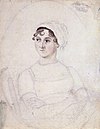Plan of a Novel, according to Hints from Various Quarters is a short satirical work by Jane Austen, probably written in May 1816. It was published in complete form for the first time by R. W. Chapman in 1926, extracts having appeared in 1871. It has been said that "in the Plan and the correspondence from which it arose, we have the most important account of what Jane Austen understood to be her aims and capacities as a novelist".
Background
In October 1815 Austen was approached via letter by the Rev. James Stanier Clarke, librarian to the Prince Regent. The Prince greatly admired Austen's novels, to the point of owning multiple copies so as to have a set in each of his residences. Learning that Austen was staying with her brother in London, negotiating the publication of Emma, Clarke invited Austen to visit and be shown around the library of the Prince's London home, Carlton House. During the visit, Clarke suggested that the Prince wished to be the dedicatee of Austen's next novel: as Clarke put it, because the Prince admired Austen's novels, she would be "at liberty to dedicate any future novel to him." Austen took the hint, dedicating Emma to the Prince when it was published in December 1815, although she privately disapproved of the Prince's lax morals and treatment of his wife.
The correspondence between Austen and Clarke continued beyond their meeting at Carlton House. He had ideas for her fiction, including a novel to be based on a clergyman with a foothold in urban life, as well as the provincial rural settings she had used so far for clerics in her novels. Another suggestion, made following the announcement of the engagement of Princess Charlotte of Wales and Prince Leopold of Saxe-Coburg-Saalfield, was an historical novel on the House of Coburg. Austen tactfully side-stepped these suggestions with disclaimers about her talents, quipping that she "could no more write a Romance than an Epic Poem."
Content and humour of the Plan
The intention of the work was to set down the essential parts of the "ideal novel". Austen was following, and guying, the recommendations of Clarke. The work was also influenced by some of Austen's personal circle with views on the novel of courtship, and names are recorded in the margins of the manuscript; they included William Gifford, her publisher, and her niece Fanny Knight.
The Plan became a sort of family joke among the Austens. Some of its aspects parody contemporary works by authors such as Sophie Cottin, Fanny Burney, Anna Maria Porter, and Mary Brunton. The satire of the Plan was analysed by Austen's nephew James Edward Austen-Leigh, in his biography A Memoir of Jane Austen (1869, expanded edition 1871).
References
- Irene Collins (2002). Jane Austen and the Clergy. Hambledon Press. ISBN 1-85285-114-7.
Notes
- ^ Paul Poplawski (1 January 1998). A Jane Austen Encyclopedia. Greenwood Publishing Group. pp. 238–9. ISBN 978-0-313-30017-2. Retrieved 4 September 2013.
- William Baker (1 January 2008). Critical Companion to Jane Austen: A Literary Reference to Her Life and Work. Infobase Publishing. p. 361. ISBN 978-1-4381-0849-0. Retrieved 4 September 2013.
- B. C. Southam (15 April 2006). Jane Austen's Literary Manuscripts: A Study of the Novelist's Development Through the Surviving Papers. Continuum. p. 80. ISBN 978-0-8264-2592-8. Retrieved 4 September 2013.
- ^ "Letter from Jane Austen to James Stanier Clarke, 1 April 1816".
- Myer, Valerie Grosvenor (1997). Jane Austen : obstinate heart : a biography (1. North American ed.). New York: Arcade Publ. p. 215. ISBN 9781559703871.
- Austen wrote in a letter to Martha Lloyd on 16 February 1813 of the Prince's infidelities and his wife: "I am resolved at least always to think that she would have been respectable, if the Prince had behaved only tolerably by her at first."
- Collins, p. 1.
- Claire Lamont, Jane Austen and the Old, The Review of English Studies New Series, Vol. 54, No. 217 (Nov., 2003), pp. 661-674, at p. 663. Published by: Oxford University Press. JSTOR 3661480.
- Deborah Kaplan (1994). Jane Austen Among Women. JHU Press. p. 184. ISBN 978-0-8018-4970-1. Retrieved 4 September 2013.
- ^ Thomas Keymer; Jon Mee (17 June 2004). The Cambridge Companion to English Literature, 1740-1830. Cambridge University Press. p. 256. ISBN 978-0-521-00757-3. Retrieved 4 September 2013.
| Jane Austen | ||||||||
|---|---|---|---|---|---|---|---|---|
| Works |
|  | ||||||
| Places | ||||||||
| Family and people | ||||||||
| Analysis | ||||||||
| Portrayals |
| |||||||